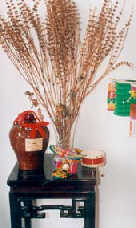 The lanterns are a delicate combination of many artistic techniques likepaper cutting,papercarving, paperhanging, and drawing. Both the construction style of classicSuzhou Gardens, and the Wu-style painting in theMing Dynasty(1368-1644) influenced Suzhou colored lanterns, and helped form a unique artistic style. On the lanterns are paintings mainly of pavilions, pagodas and towers. Human figures, landscape, birds and flowers are used as decorations, forming a strong folk art flavor on the south ofYangtze River. Among Suzhou's various colored lanterns,zou ma deng(galloping horse lantern), with its famous ingenious design, is probably the most famous. The lantern has a revolving circle ofpaper-cutlanterns or other figures. When the candle is lit, the circulation caused by the fire will make the inner circle revolve. The story on the paper-cut can then be read with flowing pictures. Nowadays, Suzhou's lantern-making techniques has become more advanced, and though the custom of watching lanterns in theSpring Festivalhas largely disappeared, new colored lanterns incorporating the modern technology still attract people all over the country to buy lanterns in Suzhou.
The lanterns are a delicate combination of many artistic techniques likepaper cutting,papercarving, paperhanging, and drawing. Both the construction style of classicSuzhou Gardens, and the Wu-style painting in theMing Dynasty(1368-1644) influenced Suzhou colored lanterns, and helped form a unique artistic style. On the lanterns are paintings mainly of pavilions, pagodas and towers. Human figures, landscape, birds and flowers are used as decorations, forming a strong folk art flavor on the south ofYangtze River. Among Suzhou's various colored lanterns,zou ma deng(galloping horse lantern), with its famous ingenious design, is probably the most famous. The lantern has a revolving circle ofpaper-cutlanterns or other figures. When the candle is lit, the circulation caused by the fire will make the inner circle revolve. The story on the paper-cut can then be read with flowing pictures. Nowadays, Suzhou's lantern-making techniques has become more advanced, and though the custom of watching lanterns in theSpring Festivalhas largely disappeared, new colored lanterns incorporating the modern technology still attract people all over the country to buy lanterns in Suzhou.
Haining, most widely for its Qiantang Bore natural wonder, is another renowned hometown of colored lanterns. The ancient town Xiashi has a time-honored tradition of colored lantern making, with some believing it to have a history of more than 1,000 years, starting from theTang Dynastyand thriving in the Song Dynasty (960-1279). The Haining colored lanterns incorporate craftwork,calligraphyand painting.Haining colored lanterns are specially known for their elaborate pinprick craft, which was enlisted as tributes to the emperor early in the Song Dynasty. The lanterns apply bamboo strips as the frame, covered by paper with paintings. The excelling pinpricked picture workmanship is completely handmade. This kind of lantern usually requires more than 10,000 pinpricks to form a picture, with some big ones requiring as many as 200,000 to 300,000. The light in the lantern beams out through the many tiny holes, forming a vividly shaped picture.
Xiashi colored lanterns are not only widely recognized on the south of Yangtze River, but also enjoy international fame. Even before the founding of thePeople's Republic of China, the lantern twice won medals at international expositions. In 1955, the late premiere Zhou Enlai presented Xiashi lanterns to honored guests from Sri Lanka, and in 1994 the Haining local government gave a pair of lanterns to Lee Kuan Yew, the Minister Mentor of the Republic of Singapore, winning high acclaim.